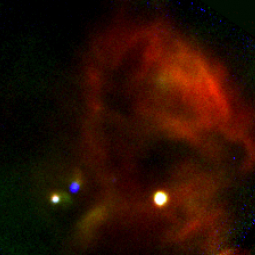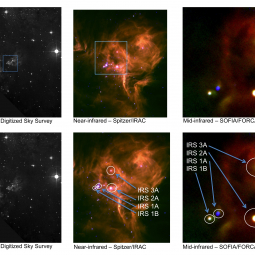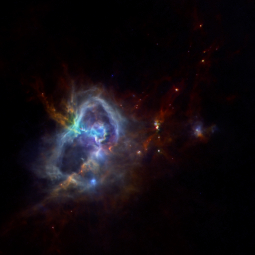A new image from NASA's Stratospheric Observatory for Infrared Astronomy, or SOFIA, provides the highest resolution mid-infrared image taken to-date of the massive star formation region in our galaxy known as W40.
The W40 image was taken by the Faint Object infraRed Camera for the SOFIA Telescope (FORCAST) instrument mounted in the airborne observatory – a highly modified 747SP airliner carrying a reflecting telescope with an effective diameter of 100 inches (2.5 meters). The image of W40 is a composite of data captured by the FORCAST camera at infrared wavelengths of 5.4, 24.2, and 34.8 microns, all of which are partially or completely blocked by water vapor in Earth’s atmosphere and inaccessible to observatories even on high mountain tops.
W40 is difficult to view with optical telescopes because it lies on the far side of a very dense cloud of gas and dust. Infrared observations of the region peer through the dust to reveal a bright nebula and dozens of young stars with at least six massive stars, six to 20 times the mass of the sun, forming at the center.
At least 50 percent of the stars in the Milky Way Galaxy formed in massive clusters of thousands of stars similar to W40. Evidence suggests that the solar system developed in such a cluster almost 5 billion years ago. Because stars are relatively dim at the wavelengths measured by FORCAST, the observed emission in the images is due to dust surrounding the stars that is heated to a few hundred degrees.
SOFIA is a joint project of NASA and the German Aerospace Center (DLR), and is based and managed at NASA's Dryden Aircraft Operations Facility in Palmdale, Calif. NASA's Ames Research Center in Moffett Field, Calif., manages the SOFIA science and mission operations in cooperation with the Universities Space Research Association (USRA), headquartered in Columbia, Md., and the German SOFIA Institute (DSI) at the University of Stuttgart.
About the Images
Mid-infrared image of the W40 star forming region
The SOFIA/FORCAST image produced by Basic Science Principal Investigators Ralph Shuping (Space Science Institute, Boulder, Colo.) and Bill Vacca (SOFIA USRA staff scientist) is the highest angular resolution mid-infrared picture of the star-forming region W40 ever made. Astronomers locate and study such regions to understand how our sun and its family of planets including Earth originally formed.
“W40 is a relatively nearby region of active star formation, but has been neglected over the years because it lies on the far side of a very dense cloud of gas and dust, making it difficult to view with optical telescopes,” said Shuping. “Infrared observations of the region, however, allow us to peer through the dust and see a bright nebula with dozens of young stars forming. Our observations with SOFIA will allow us to study the warm gas and dust disks surrounding these stars.”
“Normal stars are relatively dim at the wavelengths measured by FORCAST, so any emission that shows up from the sources in our images will be due to dust heated to a few hundred degrees Kelvin -- roughly room temperature, warm by astronomical standards,” said Vacca. “This emission is coming from dust in disks surrounding the stars. When combined with other observations from both ground and space-based observatories, the SOFIA data will allow us to determine basic characteristics of these disks including diameter, thickness, and mass. In some cases, the dust and gas in these disks may be condensing into planetary systems.”
Comparison of images of the W40 star-forming region made at wavelengths ranging from visible light to far infrared
The name W40 designates this object’s number in a catalog of HII regions, clouds of ionized hydrogen often associated with star formation and massive stars. W40 is in the constellation Aquila the Eagle, visible in the Northern hemisphere’s autumn sky. W40 itself is a difficult target for optical astronomers because it lies less than 3 degrees from the central plane of the Milky Way, at a distance of about 1600 light years behind obscuring clouds of interstellar dust and gas.
(Left column) This visible-light image is from the Digitized Sky Survey, a compendium of astronomical data archived at the Space Telescope Science Institute. The W40 region is not especially prominent at visual wavelengths due to intervening interstellar dust. Traces of both bright nebulae and dense, opaque dark clouds can be seen in this view. The light sources in this image are stars, starlight reflected from nebular material, and the glow of nebular gas ionized by ultraviolet radiation from the stars. The blue box shows the field of view covered by the near-infrared images in the middle column. (NASA / ESA / NSF / AURA / STScI / DSS).
(Middle Column) This near-infrared image is a composite produced by SOFIA Basic Science Principal Investigators Shuping and Vacca using archived Spitzer infrared space telescope data. The interstellar dust in the foreground and within the W40 region is mostly transparent at these wavelengths, so W40 stands out prominently and one can view into the interior of the nebula to see embedded protostars. Some of these objects were labeled with IRS (“InfraRed Source”) numbers by earlier investigators. The bright sources in this image are stars, protostars, nebular gas, and hot dust surrounding the embedded stars. The blue box shows the field of view covered by the mid-infrared images in the right column. (The component Spitzer images were taken by the IRAC camera at wavelengths of 3.6, 4.5, and 8.0 microns.) (NASA / Spitzer / Caltech-JPL / IRAC team)
(Right Column) This mid-infrared image is a composite of 5.4 micron (blue), 24.2 micron (green) and 34.8 micron (red) images taken with SOFIA’s FORCAST camera in May 2011 by Shuping and Vacca. The field of view is approximate 3 arcminutes on a side. The bright sources in this image are protostars and thermal emission from dust and gas that are construction material for new stars and planets. Emission at 24 and 35 microns is primarily from warm dust, both in the background nebula and in the circumstellar environments of the stellar sources. Some of the protostars seen in the Spitzer near-infrared image are seen here, but the SOFIA data allow easier determination of their dust temperatures. The hottest object, appearing blue and located at lower left, has very little dust surrounding it and is likely nearest to completing its evolution into a fully-fledged star. The other protostars represented by white in this color balance are cooler and thus have a large amount of circumstellar dust, some of it probably in a disk surrounding the central star. Hence these stars are still in the process of forming out of their natal gas and dust. At the upper right is the source IRS 3A which appears as a single star at shorter wavelengths (e.g. in the optical and Sptizer images), but becomes a large, roughly circular patch of emission in our FORCAST images. This is still somewhat of a mystery, but it is possible that IRS 3A is a protostar embedded in a small “cocoon” of gas and dust left over from its initial formation. (NASA / DLR / USRA / DSI / Shuping & Vacca / FORCAST team)
Points of Contact
Nicholas A. Veronico
SOFIA Science Center
NASA Ames Research Center, Moffett Field, Calif.
650-604-4589
nveronico@sofia.usra.edu
Beth Hagenauer
Dryden Flight Research Center, Edwards, Calif.
661-276-7960
beth.hagenauer-1@nasa.gov


